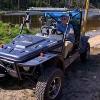This thing just cracks me up :)
-
Similar Topics
-
By FTG-05
I want to ditch my Kubota RTV-XG850 and its moronic twitchy throttle design flaw, get rid of the problematic engine and the 40 mph purposely throttled speed.
So far, I'm looking at the Honda Pioneer 1000 and the Polaris Ranger 1000, both of which have 1000-1500 lb payload bed capacity.
What other makes and models should I be looking at?
Thanks for the help!
-
By NHTracker
I have a 2020 Tracker 800SX LE that I bought new in 2020. Yesterday I noticed two cracks in the bed on the inside corners at the tailgate end. They go all the way through. I use it around the property moving firewood, dirt and stuff. Never put stress on the sides of the bed. Has anyone else had this problem? Is there a fix? Help!!!
-
By NHTracker
I have 2020 Tracker 800SX LE that I bought new in 2020. Yesterday i noticed two cracks in the bed in the corners at the tailgate end. They go all the way through the bed. I use it around the property moving firewood, dirt and stuff. Don't know how they could occur. Has anyone else had this problem? Is there a fix? Help!!!
-
-
By nods
Less than 40 miles can barely start. Dealer is working with Hisun on a number of other issues on this UTV. Can not get clear info on the meaning of these E codes this is getting. Anybody have some clear info for me?
-







Recommended Posts
Join the conversation
You can post now and register later. If you have an account, sign in now to post with your account.
Note: Your post will require moderator approval before it will be visible.